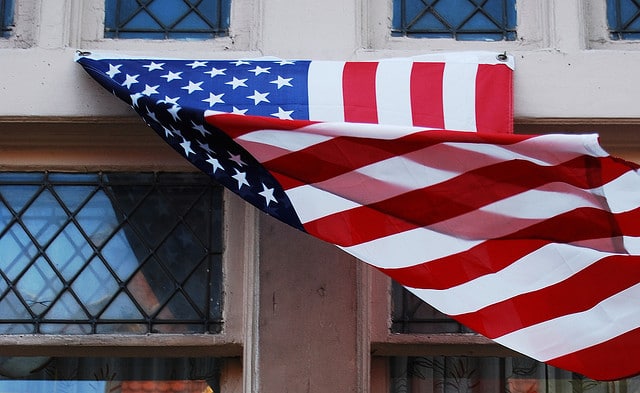American Flag Guidelines: How To Display and Care For The American Flag
Many of our readers ask about U.S. flag rules and regulations. On June 22, 1942, Congress passed a joint resolution, later amended on December 22, 1942, that encompassed what has come to be known as the U.S. Flag Code. Here are highlights: (Adapted from The Farmer’s Almanac)
Perhaps the most important rule involves how citizens should behave around the Stars and Stripes: The flag of the United States is the emblem of our identity as a separate nation, which the United States of America has been for more than 200 years. Therefore, citizens should stand at attention and salute when their flag is passing in a parade or being hoisted or lowered. (Please, make sure your flag is Made in USA. Check out these Made in USA American Flags we found. The country of origin read Made in USA, but please, double check before purchasing.)
HOW TO PROPERLY DISPLAY THE FLAG
- The custom is to display the flag only from sunrise to sunset on flagstaffs in the open, but it may be displayed at night upon special occasions to produce a patriotic effect.
- When hung vertically on a wall, window or door the Union (blue) should be to the observer’s left. When the flag is hung either horizontally or vertically against a wall, the Union (blue field) should be to the observer’s left.
- The flag should be hoisted briskly and lowered ceremoniously.
- It should not be displayed on days when the weather is inclement.
- The flag should be displayed on all days, especially on
- New Year’s Day, January 1
- Inauguration Day, January 20
- Martin Luther King Jr.’s birthday, third Monday in January
- Lincoln’s Birthday, February 12
- Washington’s Birthday, third Monday in February
- Easter Sunday (variable)
- Mother’s Day, second Sunday in May
- Armed Forces Day, third Saturday in May
- Memorial Day (half-staff until noon), the last Monday in May
- Flag Day, June 14
- Father’s Day, third Sunday in June
- Independence Day, July 4
- Labor Day, first Monday in September
- Constitution Day, September 17
- Columbus Day, second Monday in October
- Navy Day, October 27
- Veterans Day, November 11
- Thanksgiving Day, fourth Thursday in November
- Christmas Day, December 25
- and such other days as may be proclaimed by the President of the United States
- the birthdays of States (date of admission)
- and on State holidays.
- It should be displayed at every public institution and in or near every polling place on election days, and at schoolhouses during school days.
- In a procession it is to the right of another flag or, if in a line of other flags, in front of the center of that line.
- It should not be displayed on a float except from a staff, nor draped over the hood, top, sides, or back of a vehicle.
- When displayed on a vehicle, the staff should be fixed firmly to the chassis.
- No other flag should be placed above the flag of the United States or, if on the same level, to its right.
- The United Nations flag may not be displayed above or in a position of superior prominence to the United States flag except at United Nations Headquarters.
- The flag displayed with another against a wall, from crossed staffs, should be on the right (the flag’s own right), and its staff should be in front of the other staff.
- It should be at the center and the highest point when displayed with a group of state flags.
- When flags of states, cities, etc., are flown on the same halyard, the United States flag should be at the peak.
- When flags of two or more nations are displayed, they are to be flown from separate staffs of the same height, and the flag of the United States should be hoisted first and lowered last.
- When displayed from a staff projecting from a building, the union [upper inner corner] should be at the peak of the staff.
- When it is displayed otherwise than by being flown from a staff, it should be displayed flat, whether indoors or out, or so suspended that its folds fall as freely as though it were staffed.
- When displayed over a street, it should be suspended vertically with the union to the north in an east and west street, or to the east in a north and south street.
- On a platform, it should be above and behind the speaker, with the union uppermost and to the observer’s left.
- When displayed from a staff in a church or auditorium, it should occupy the position of honor and be placed at the speaker’s right as he faces the audience.
- When flown at half-staff, the flag should be first hoisted to the peak for an instant and then lowered to half-staff position. It should again be raised to the peak before it is lowered for the day. Half-staff is one-half the distance between the top and bottom of the staff. The flag must be flown at half-staff on all buildings on the death of any officer listed below, for the period indicated:
- For the President or a former President: 30 days from the date of death.
- For the Vice President, the Chief Justice or a retired Chief Justice of the United States, or the Speaker of the House of Representatives: 10 days from the day of death.
- For an Associate Justice of the Supreme Court, a member of the Cabinet, a former Vice President, the President pro tempore of the Senate, the Majority Leader of the House of Representatives, the Minority Leader of the House of Representatives: From the day of death until interment.
- For a United States Senator, Representative, Delegate, or the Resident Commissioner from the Commonwealth of Puerto Rico: the flag should be flown in the metropolitan area of the District of Columbia, on the day of death and on the following day; in the state, congressional district, territory, or Commonwealth of such Senator, Representative, Delegate, or Commissioner, from the day of death until interment.
- For a Governor: Within the state, territory, or possession, from the day of death until interment.
- When the flag is used to cover a casket, the union should be at the head and over the left shoulder.
HOW NOT TO DISPLAY THE FLAG
- The flag should not be dipped to any person or thing.
- It should never be displayed with the union down, save as a signal of dire distress.
- It should never touch anything beneath it, such as the ground, the floor, water, or merchandise.
- It should never be carried flat or horizontally, but always aloft and free.
- It should never be fastened, displayed, used, or stored so that it might be easily torn, soiled, or damaged in any way.
- It should never be used as covering for a ceiling.
- It should never have anything placed on it.
- The flag should never be used for any advertising purpose, nor embroidered on cushions or handkerchiefs, printed on paper napkins or boxes, nor used as any portion of a costume.
- When the flag is in such condition that it is no longer a fitting emblem, it should be destroyed in a dignified way, preferably by burning.
Please, make sure your flag is Made in USA. Check out these Made in USA American Flags we found. The country of origin read Made in USA, but please, double check before purchasing.





I’ve received flags from dav.made in china and told them no more donations if not made in USA.
Same here, but a number of charitable organizations do the same. Do not buy any American Flag that does not have a label identifying it as made in America. When you find one that does not indicate its place of manufacture , it was not made in our Country.
Long may it wave!